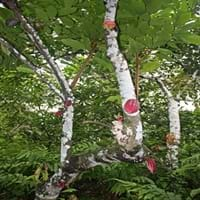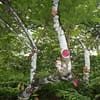Life Span
Perennial
Perennial
Origin
Mexico, Central America
Australia
Types
Criollo, Forastero, Trinitario
Not Available
Number of Varieties
Not Available
Habitat
Lowland, Tropical rainforest, Tropical regions
Scrubs, tussock grasslands, Upland savannas
USDA Hardiness Zone
11-15
10-11
AHS Heat Zone
12-10
12-10
Sunset Zone
H1, H2
8, 9, 12, 13, 14, 15, 16, 17, 18, 19, 20, 21, 22, 23, 24
Habit
Oval or Rounded
Upright/Erect
Flower Color
White
Lemon yellow
Flower Color Modifier
Bicolor
Bicolor
Fruit Color
Gold, Burgundy, Dark Red
Gray Green
Leaf Color in Spring
Light Green, Dark Green, Pink, Copper
Blue Green
Leaf Color in Summer
Light Green, Dark Green, Copper
Blue Green
Leaf Color in Fall
Light Green, Dark Green
Blue Green
Leaf Color in Winter
Dark Green
Blue Green
Leaf Shape
Broad, Unlobed
Long Narrow
Plant Season
Spring, Summer, Fall, Winter
Spring
Sunlight
Partial Sun
Full Sun
Type of Soil
Loam, Sand
Loam, Sand
The pH of Soil
Acidic, Neutral
Acidic, Neutral, Alkaline
Soil Drainage
Well drained
Well drained
Bloom Time
Indeterminate
Spring, Late Winter
Tolerances
Not Available
Drought
Where to Plant?
Ground
Ground
How to Plant?
Seedlings, Stem Planting
Seedlings
Plant Maintenance
Medium
Medium
Watering Requirements
Keep ground moist, Requires watering in the growing season
Do not water excessively
In Summer
Lots of watering
Lots of watering
In Spring
Moderate
Moderate
In Winter
Average Water
Average Water
Soil pH
Acidic, Neutral
Acidic, Neutral, Alkaline
Soil Type
Loam, Sand
Loam, Sand
Soil Drainage Capacity
Well drained
Well drained
Sun Exposure
Partial Sun
Full Sun
Pruning
Prune to stimulate growth, Prune twice a year, Remove damaged leaves, Remove dead branches, Remove dead leaves
Remove dead or diseased plant parts, Requires little pruning
Fertilizers
Ammonia sulphate, Nitrogen
All-Purpose Liquid Fertilizer, No fertilizers needed
Pests and Diseases
Borers, Insects, Phytophthora, Red blotch
Insects, Root rot
Plant Tolerance
Shade areas, Wet Site
Drought
Flower Petal Number
Single
Single
Foliage Texture
Coarse
Fine
Foliage Sheen
Glossy
Matte
Attracts
Not Available
Butterflies
Allergy
Diabetes, Diarrhea
Asthma, Eye irritation, Headache, Nose Irritation, Throat itching, Vomiting
Aesthetic Uses
Not Available
Showy Purposes
Beauty Benefits
Not Available
Not Available
Environmental Uses
Air purification
Air purification, soil stabilisation
Medicinal Uses
Anti-oxidant, Antioxidants, Asthma, Cancer, Cardiovascular problems, constipation, High cholestrol, Wounds
Not Available
Part of Plant Used
Leaves, Seeds
Flowers, Sap, Seeds
Other Uses
Employed in herbal medicine, Used for its medicinal properties, Used in making beverages
Used as a dye, Wood is used fore making tools
Used As Indoor Plant
No
No
Used As Outdoor Plant
Yes
Yes
Garden Design
Edible, Feature Plant, Fruit / Fruit Tree, Shade Trees, Tropical
Shade Trees, Street Trees
Botanical Name
THEOBROMA cacao
ACACIA aneura
Common Name
Cacao, Chocolate, Cocoa
Mulga, True Mulga
In Hindi
कोको संयंत्र
Mulga
In German
Kakaopflanze
Mulga
In French
usine de cacao
Mulga
In Spanish
planta del cacao
Mulga
In Greek
φυτό του κακάο
mulga
In Portuguese
planta do cacau
Mulga
In Polish
Kakao roślin
Mulga
In Latin
Cocos herba
Mulga
Phylum
Magnoliophyta
Magnoliophyta
Class
Magnoliopsida
Magnoliopsida
Family
Sterculiaceae
Fabaceae
Clade
Angiosperms, Eudicots, Rosids
Angiosperms, Eudicots, Rosids
Tribe
Theobromeae
Not Available
Subfamily
Byttneroideae
Not Available
Number of Species
Not Available
Importance of Cocoa Plant and Mulga Tree
Want to have the most appropriate plant for your garden? You might want to know the importance of Cocoa Plant and Mulga Tree. Basically, these two plants vary in many aspects. Compare Cocoa Plant and Mulga Tree as they differ in many characteristics such as their life, care, benefits, facts, etc. Every gardener must at least have the slightest clue about the plants he wants to plant in his garden. Compare their benefits, which differ in many ways like facts and uses. The medicinal use of Cocoa Plant is Anti-oxidant, Antioxidants, Asthma, Cancer, Cardiovascular problems, constipation, High cholestrol and Wounds whereas of Mulga Tree is Not Available. Cocoa Plant has beauty benefits as follows: Not Available while Mulga Tree has beauty benefits as follows: Not Available.
Compare Facts of Cocoa Plant vs Mulga Tree
How to choose the best garden plant for your garden depending upon its facts? Here garden plant comparison will help you to solve this query. Compare the facts of Cocoa Plant vs Mulga Tree and know which one to choose. As garden plants have benefits and other uses, allergy is also a major drawback of plants for some people. Allergic reactions of Cocoa Plant are Diabetes and Diarrhea whereas of Mulga Tree have Asthma, Eye irritation, Headache, Nose Irritation, Throat itching and Vomiting respectively. Having a fruit bearing plant in your garden can be a plus point of your garden. Cocoa Plant has showy fruits and Mulga Tree has no showy fruits. Also Cocoa Plant is not flowering and Mulga Tree is not flowering . You can compare Cocoa Plant and Mulga Tree facts and facts of other plants too.





